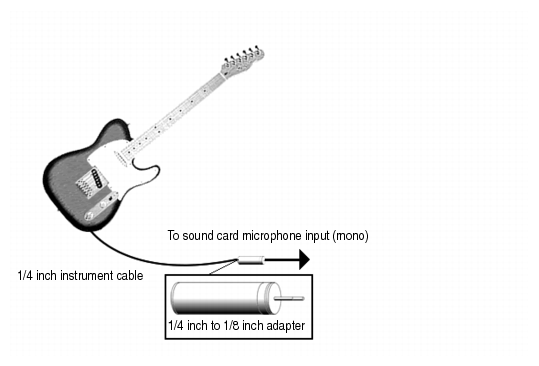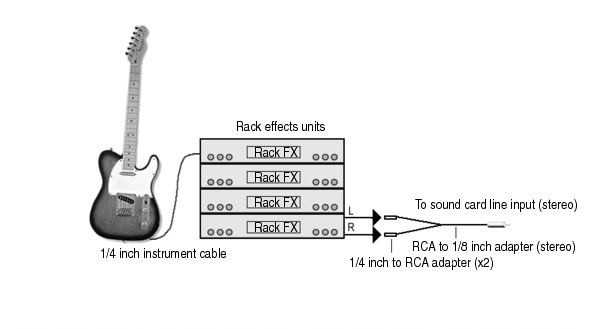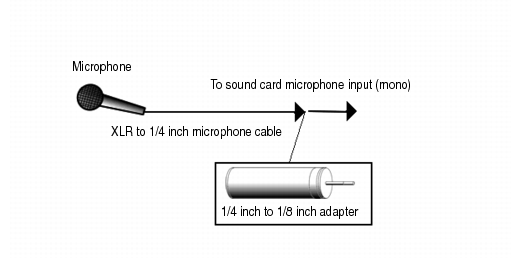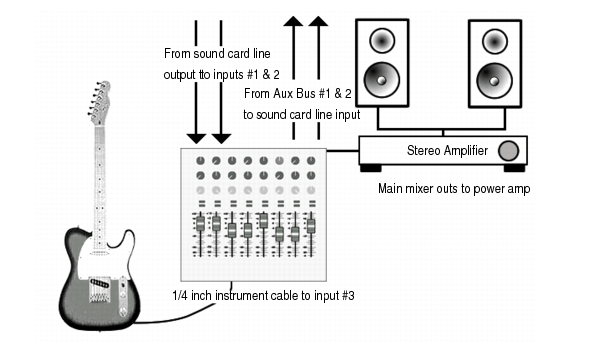In general, the inputs of sound cards take 1/8 inch stereo mini-jacks. Sound cards usually have two inputs—one for line level inputs and the other for microphones (at mic level). The line level input is stereo; the mic input could be either stereo or mono. If your final output does not terminate in a 1/8 inch jack (and it probably doesn’t), you will need an adapter to plug it into your sound card.Most sound cards use the Windows Volume Control to adjust the master input and output volumes and to control which recording inputs are active. If you don’t hear audio tracks, or if you can’t easily control the audio volume in SONAR, go to Control Panel > Hardware and Sound > Volume Control (Windows 7) and check the settings there. See your sound card’s documentation for more.You can connect an electric guitar directly to your sound card using a 1/4 inch mono to 1/8 inch stereo adapter. The following diagram shows this setup:The 1/8 inch jack should be plugged into the sound card’s mic input, although plugging into the line input may also work.You can also plug an electric guitar into an effects rack, then send the output of the rack to the sound card’s input, as shown in the following diagram:This diagram assumes that the output of the rack is at line level. If it is at pro level instead (+4 dB), and your card does not accept a +4 db input, you will need to attenuate (lower) the F/X rack’s signal. To do this, use a mixer between the rack’s output and the Y-adapter. If the rack has only a mono output, a 1/4 inch mono to 1/8 inch stereo adapter should be used instead of a Y-adapter.If you want to connect a guitar amplifier’s direct output to the sound card, you should base your setup on this example.Microphones can be plugged into the sound card’s mic input. Some inexpensive microphones are made especially for use with sound cards and come equipped with 1/8 inch jacks. However, better quality microphones take better quality cables, which do not terminate in 1/8 inch jacks. The following diagram illustrates how to connect a microphone that terminates in a 1/4 inch jack:The output of a stereo component can be connected to the sound card’s line in, using a dual RCA to 1/8 inch stereo mini Y-adapter. Many portable cassette players come with this kind of adapter, or even with a single cable with all the necessary jacks. In the following diagram, a stereo component is connected to the Y-adapter using standard RCA cables:If you are using your computer’s internal CD player, and it does not have its audio outs connected internally to the sound card, run a cable from the CD player’s Headphone jack to the card’s Line In jack. If there is no Headphone jack, you’ll need to use an external CD player.
Tip - Searching Documentation
Tip: To search for a specific topic, type your search query in the Search Cakewalk.com field at the top right of this page.
When the search results appear, click which product's documentation you would like to search to filter the search results further.
Note - Using Offline Help
Note: If you prefer to always use offline Help, go to Edit > Preferences > File > Advanced in your Cakewalk software and select Always Use Offline Help.
If you are not connected to the internet, your Cakewalk software will default to showing offline help until an internet connection becomes available.








